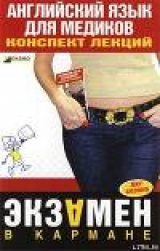
Текст книги "Английский язык для медиков: конспект лекций"
Автор книги: Елена Беликова
Жанры:
Языкознание
,сообщить о нарушении
Текущая страница: 7 (всего у книги 12 страниц)
ЛЕКЦИЯ № 23. Respiratory system
The respiratory system is structurally and functionally adapt ed for the efficient transfer of gases between the ambient air and the bloodstream as well as between the bloodstream and the tissues. The major functional components of the res piratory system are: the airways, alveoli, and blood vessels of the lungs; the tissues of the chest wall and diaphragm; the systemic blood vessels; red blood cells and plasma; and respi ratory control neurons in the brainstem and their sensory and motor connections. LUNG FUNCTION: provision of O2 for tissue metabolism occurs via four mechanisms. Ventilation – the transport of air from the environment to the gas exchange surface in the alveoli. O2 diffusion from the alveolar air space across the alveolar-capillary membranes to the blood.
Transport of O2 by the blood to the tissues: O2 diffusion from the blood to the tissues.
Removal of CO2 produced by tissue metabolism occurs via four mechanisms. CO2 diffusion from the tissues to the blood.
Transport by the blood to the pulmonary capillary-alveolar membrane.
CO2 diffusion across the capillary-alveolar membrane to the air spaces of the alveoli. Ventilation – the transport of alveolar gas to the air. Functional components: Conducting airways (conducting zone; anatomical dead space).
These airways are concerned only with the transport of gas, not with gas exchange with the blood.
They are thick-walled, branching, cylindrical structures with ciliated epithelial cells, goblet cells, smooth muscle cells. Clara cells, mucous glands, and (sometimes) cartilage.
Alveoli and alveolar septa (respiratory zone; lung parenchyma).
These are the sites of gas exchange.
Cell types include: Type I and II epithelial cells, alveolar macrophages.
The blood-gas barrier (pulmonary capillary-alveolar membrane) is ideal for gas exchange because it is very thin (‹0,5 mm) and has a very large surface area (50-100 m2). It consists of alveolar epithelium, basement membrane interstitium, and capillary endothelium.
New words
respiratory – дыхательный
structurally – структурно
functionally – функционально
adapted – приспособленный
efficient – эффективный
transfer – перемещение
gases – газы
ambient – окружающий
air – воздух
bloodstream – кровоток
airways – воздушные пути
alveoli – альвеолы
blood vessels – кровеносные сосуды
lungs – легкие
chest – грудь
diaphragm – диафрагма
the systemic blood vessels – системные кровеносные сосуды
red blood cells – красные кровяные клетки plasma – плазма
respi ratory control neurons – дыхательные нейроны контроля
brainstem – ствол мозга
sensory – сенсорный
motor connections – моторные связи
ventilation – вентиляция
transport – транспортировка
environment exchange – окружающая среда
surface – поверхность
Запомните!
Един. ч. – множ. ч.
this is – these are
that is – those are
there is – there are
it is – they are
Поставьте слова в следующих предложениях во множественное число.
1. This is a star.
2. This is a boy.
3. This is a baby.
4. That is a plate.
5. That is a flower.
6. That is a bookshelf.
7. Is this a sofa?
8. Is this a bookcase?
9. Is this a man?
10. Is that a ball?
11. Is that a train?
12. Is that a plane?
13. Is the window open?
14. Is the door closed?
15. Is the boy near the window?
16. That is not a king.
17. That is not a queen.
18. That is not a bus.
19. That isn't a mountain.
20. That isn't a goose.
21. This isn't a mouse.
22. It is a sheep.
23. It is a cigarette.
24. It is a cat.
25. It is not a girl.
26. It isn't a bag.
27. It isn't a tree.
28. It is not a bad egg.
29. It is a good egg.
30. Is that a flower?
31. This man is an engineer.
32. That woman is my sister.
33. This child is my son.
34. That goose is big.
35. This mouse is white.
36. This man is a doctor.
37. That woman is my cousin. She is a teacher
38. That girl is my niece. She is a pupil.
39. This girl has a blue sweater.
40. This boy has a good coat.
41. My uncle has a large flat.
42. There is a table in the room.
43. I have a good pen. My pen is in my pocket.
44. There is a flower in the vase.
45. This child's foot is sore.
Answer he questions.
1. What is the respiratory system structurally adopted?
2. What does the respiratory system transfer?
3. What are the most major lung functions?
4. What do we breath in?
5. What do we breath out?
6. How is the oxygen delivered to the organs?
7. How is oxygen delivered to the organs?
8. What is metabolism?
9. What are the functional components?
10. What do cell types include?
Make the sentences of your own using the new words (10 sentences).
Find plural and single in the text.
Find one word, which is a little bit different in meaning from others (найдите одно слово, которое немного отличается от других по смыслу):
1. a) palm; b) blood; c) vessel;
2. a) leg; b) tissue; c) metabolism;
3. a) airways; b) alveoli; c) arm;
4. a) intestines; b) cell; c) membrane;
5. a) oxygen; b) breath; c) carbon.
ЛЕКЦИЯ № 24. Lung volumes and capacities
Lung volumes – there are four lung volumes, which when added together, equal the maximal volume of the lungs. Tidal volume is the volume of one inspired or expected normal breath (average human = = 0,5 L per breath). Inspiratory reserve volume is the volume of air that can be inspired in excess of the tidal volume. Expiratory reserve volume is the extra an that can be expired after a normal tidal expiration.
Residual volume is the volume of gas that re lungs after maximal expiration (average human = 1,2 L).
Lung capacities are comprised of two or more of the lung volumes. Total lung capacity is the volume of gas that can be con tained within the maximally inflated lungs (average human = 6 L).
Vital capacity is the maximal volume that can be expelled after maximal inspiration (average human = 4,8 L).
Functional residual capacity is the volume remaining in the lungs at the end of a normal tidal expiration (average luman = 2,2 L).
Inspiratory capacity is the volume that can be taken into the lungs after maximal inspiration following expiration of a normal breath. Residual volume can not be directly measured by spirometry. Because FRC and TLC include the residual capacity, they can not be directly measured by spirometry either. Helium dilution techniques are used to determine these capacities. A forced vital capacity is obtained when a subject inspires maximally and then exhales as forcefully and as completely as possible. The forced expiratory volume (FEV1) is the volume of air exhaled in the first second. Typically, the FEV1 is approximate 80% of the FVC. In obstructive lung diseases, such as bronchial asthma, the FEV1 is reduced much more that the FVC, producing a to FEV1 / FVC. In restrictive lung diseases, such as pulmonary fibro-sis, both the FEV1, and the FVC are reduced. This characteristically produces a normal or increased FEV1/ FVC.
GAS LAWS AS APPLIED TO RESPIRATORY PHYSIOLOGY: Dalton's Law: In a gas mixture, the pressure exerted by each gas is independent of the pressure exerted by the other gases.
A consequence of this is as follows: partial pressure = total pressure x fractional concentration. This equation can be used to determine the partial pressure of oxygen in the atmosphere. Assuming that the total pressure (or barometric pressure, PB) is atmospheric pressure at sea level (760 mmHg) and the fractional concentration of O2 is 21%, or 0,21: P02 = 760 mmHg ч 0,21 = 160 mmHg. As air moves into the airways, the partial pressures of the vari ous gases in atmospheric air are reduced because of the addi tion of water vapor (47 mmHg). Henry's Law states that the concentration of a gas dissolved in liquid is proportional to its partial pressure and its solubility coef ficient (Ks). Thus, for gas X, [X] = Ks ч Px
Fick's Law states that the volume of gas that diffuses across a barrier per unit time is given by:
Vgas = YxDx(P1 – P2)
where A and T are the area and thickness of the barrier, P1 and P2 are the partial pressures of the gas on either side of the barrier and D is the diffusion constant of the gas. D is directly proportional to the solubility of the gas and inversely proportional to the square root of its molecular weight.
New words
lung – легкое
volume – объем
equal – равный
the maximal – максимальный
tidal – вдыхаемый и выдыхаемый
inspired – вдохновленный
expected – ожидаемый
normal – нормальный
breath – дыхание
average – среднее число
human – человек
reserve – зарезервировать
residual – oстаточный
helium – гелий
dilution – растворение
techniques – методы
to be used to – использовать
to determine – определять
capacities – возможности
Поставьте слова в следующих предложениях во множественное число.
1. This room is very large.
2. There is a match in the box.
3. Has this lady a knife?
4. There is a man and a woman in the street.
5. This lady is that gen tleman's wife.
6. This shoe is too large for my foot.
7. The child is sitting on a bench.
8. My tooth is white.
9. This key is made of steel.
10. A potato is a vegetable and a cherry is a fruit.
11. This is my friend's study.
12. What is that child's name?
13. The cat has caught a mouse.
14. There was a lady, a gentleman, a boy and a girl in the room.
15. In the farm-yard we could see an ox, a sheep, a cow and a goose.
16. Is worker an Englishman or a German?
17. He is a Frenchman.
18. Why don't you eat this potato?
19. This strawberry is still green.
20. The withered leaf has fallen to the ground.
21. Can you see a bird in that tree?
22. Does your tooth still ache?
23. I held up my foot to the fire to warm it.
24. His child studies very well.
25. This man works at the office.
26. There is a new house in our street.
27. This story is very interesting.
28. I have hurt the foot.
29. The wolf has been shot.
30. He keeps his toy in a box.
31. Put this knife on that table.
32. I see a pupil.
Притяжательный падеж существительных / (Possessive case)
The child's toys – The children's toys
The boy's books – The boys' books
Перефразируйте следующие словосочетания и предложения, употребляя притяжательный падеж.
1. The room of my friend.
2. The questions of my daughter.
3. The wife of my brother.
4. The table of our teacher.
5. The poems of Shakespeare.
6. The voice of this girl.
7. The new club of the workers.
8. The letter of Pete.
9. The car of my parents.
10. The life of this woman.
Answer the questions.
1. How many lung volumes are there?
2. Are the lung volumes added together?
3. How can inspiratory reserve volume be inspired?
4. Can inspiratiry reserve volume be expired after a normal tidal expiration?
5. What is residual volume?
6. How are lungs capacities be composed?
7. Is vital capacity the maximal volume?
8. What is the functional residual capacity?
9. What is the inspiratory capacity?
10. Can residual volume be directly measured by spirometry?
Make the sentences of your own using the new words (10 sentences).
Make your own sentences using possessive case (10 sentences).
Find one word, which is a little bit different in meaning from others (найдите одно слово, которое немного отличается от других по смыслу):
1. a) volume; b) head; c) lung;
2. a) air; b) breathing; c) hot;
3. a) stomach; b) bronchi; c) lungs;
4. a) nose; b) trachea; c) finger;
5. a) eye; b) alveoli; c) bronchi.
ЛЕКЦИЯ № 25. Ventilation
Total ventilation (VT, minute ventilation) is the total gas flow into the lungs per minute. It is equal to the tidal volume (VT) x the respiratory rate (n). Total ventilation is the sum of dead space ventilation and alveolar ventilation.
Anatomic dead space is equivalent to the volume of the conducting airways (150 mL in normal individuals), i. e., the trachea and bronchi up to and including the terminal bronchioles. Gas exchange does not occur here. Physiologic dead space is the volume of the respiratory tract that does not participate in gas exchange. It includes the anatomic dead space and partially functional or nonfunctional alveoli (e. g., because of a pulmonan embolus preventing blood supply to a region of alveoli). In normal individuals, anatomic and physiologic dead space are approximately equal. Physiologic dead space can greatly exceed anatomic dead space in individuals with lung disease.
Dead space ventilation is the gas flow into dead space per minute. Alveolar ventilation is the gas flow entering functional alveoli per minute.
Alveolar ventilation: It is the single most important parameter of lung function. It cannot be measured directly. It must be adequate for removal of the CO2 produced by tissue metabolism whereas the partial pressure of inspired O2 is 150 mmHg, the partial pressure of O2 in the alveoli is typically 100 mmHg because of the displacement of O2 with CO2. PAo2 cannot be measured directly.
New words
total – общее количество
ventilation – вентиляция
flow – поток
per minute – в минуту
equal – равный
the conducting – проведение
airways – воздушные пути
exchange – обмен
tract – трактат
to be measured – быть измеренным
directly – непосредственно
displacement – смещение
Перефразируйте следующие словосочетания и предложения, употребляя притяжательный падеж.
1. The handbags of these women.
2. The flat of my sister is large.
3. The children of my brother are at home.
4. The room of the boys is large.
5. The name of this girl is Helen.
6. The work of these students is interesting.
7. The dog of the brother.
8. The notebook of the teacher.
9. The friend of my friend.
10. The work of the scientist.
Переведите на английский язык, употребляя притяжательный падеж.
1. Он показал мне письмо своей сестры.
2. Она взяла коньки своего брата.
3. Дайте мне тетради ваших учеников.
4. Принесите вещи ваших детей.
5. Вчера дети нашли птичье гнездо.
6. Это семья моего друга.
7. Чья это сумка? Это сумка Тома.
8. Чьи это словари? – Это словари студентов.
9. Вы видели книгу нашего учителя?
10. Мне нравится почерк этого мальчик.
Answer the questions.
1. How minutes does it take for total ventilation?
2. Is total ventilation equal to the tidal volume?
3. Describe the process of total ventilation?
4. Is anatomic dead space equipment to the volume of the conducting airways?
5. Does gas exchange occur in trachea and bronchi?
6. What is physiological dead space?
7. What does physiological dead space include?
8. Describe the alveolar ventilation?
9. What is the most important parameter of lung function?
10. What does tissue metabolism produce?
Make the sentences of your own using the new words (10 sentences).
Make your own sentences using possessive case (10 sentences).
Find one word, which is a little bit different in meaning from others (найдите одно слово, которое немного отличается от других по смыслу):
1) a) nose; b) mouth; c) nail;
2) a) lungs; b) bronchi; c) stomach;
3) a) brain; b) rib; c) thorax;
4) a) tissue; b) bone; c) pelvis;
5) a) arm; b) shoulder; c) finger.
ЛЕКЦИЯ № 26. Air flow
Air moves from areas of higher pressure to areas of lower pres sure just as fluids do. A pressure gradient needs to be established to move air.
Alveolar pressure becomes less than atmospheric pressure when the muscles of inspiration enlarge the chest cavity, thus lowering the in-trathoracic pressure. Intrapleural pressure decreases, caus ing expansion of the alveoli and reduction of intra-alveolar pressure. The pressure gradient between the atmosphere and the alveoli drives air into the airways. The opposite occurs with expiration.
Air travels in the conducting airways via bulk flow (mL/min). Bulk flow may be turbulent or laminar, depending on its velocity. Velocity represents the speed of movement of a single particle in the bulk flow. At high velocities, the flow may be turbulent. At lower velocities transitional flow is likely to occur. At still lower velocities, flow may be laminar (streamlined). Reynold's number predicts the air flow. The higher the number, the more likely the air will be turbulent. The velocity of particle movement slows as air moves deeper into the lungs because of the enormous increase in cross-sectional area due to branching. Diffusion is the primary mechanism by which gas moves between terminal bronchioles and alveoli (the respiratory zone).
Airway resistance: The pressure difference necessary to produce gas flow is directly related to the resistance caused by friction at the airway walls. Medium-sized airways (› 2 mm diameter) are the major site of airway resistance. Small airways have a high individual resis tance. However, their total resistance is much less because resistances in parallel add as reciprocals.
Factors affecting airway resistance: Bronchoconstriction (increased resistance) can be caused by parasympathetic stimulation, histamine (immediate hyper-sensitivity reaction), slow-reacting substance of anaphylaxis (SRS-A = leukotrienes C4, D4, E4; mediator of asthma), and irritants. Bronchodilation (decreased resistance) can be caused by sympathetic stimulation (via beta-2 receptors). Lung volume also affects airway resistance. High lung vol umes lower airway resistance because the surrounding lung parenchyma pulls airways open by radial traction. Low lung volumes lead to increased airway resistance because there is less traction on the airways. At very low lung vol umes, bronchioles may collapse. The viscosity or density of inspired gases can affect airway resistance. The density of gas increases with deep sea div ing, leading to increased resistance and work of breathing. Low-density gases like helium can lower airway resistance During a forced expiration, the airways are compressed by increased intrathoracic pressure. Regardless of how forceful the expiratory effort is, the flow rate plateaus and cannot be exceeded. Therefore, the air flow is effort-independent; the collapse of the airways is called dynamic compression. Whereas this phenomenon is seen only upon forced expira tion in normal subjects, this limited flow can be seen dur ing normal expiration in patients with lung diseases where there is increased resistance (e. g., asthma) or increased compliance (e. g., emphysema).
New words
to move – перемещаться
from – от area – область
higher – выше
pressure – давление
lower – ниже
just – только
fluids – жидкости
gradient – градиент
to be established – быть установленным
intrapleural – внутриплевральный
to decrease – уменьшаться
caus ing – порождение
expansion – расширение
reduction – сокращение
intra-alveolar – внутриальвеолярный
atmosphere – атмосфера
opposite – напротив
expiration – истечение
collapse – коллапс
viscosity – вязкость
density – плотность
Местоимения some, any, no, every и их производные
Some обозначает некоторое количество.
Употребляется в следующих случаях.
1. Утвердительная форма: «We have some dictionaries».
2. Отрицательная форма: «We have no dictionaries».
3. Вопросительная форма: «Have you any dictionaries?»
Вставьте some, any, no.
1. There are… pictures in the book.
2. Are there… new students in your group?
3. There are… old houses in our street.
4. Are there… English text books on the desks? – Yes, there are…
5. Are there… maps on the walls? – No, there aren't…
6. Are there… pens on the desk? – Yes, there…
7. Are there… sweets in your bag? – Yes, there are…
8. Have you got… English books at home? – Yes, I have…
9. There are… beautiful pictures in the magazine.
10. I have. nice gloves.
11. There are.ink in my pen.
12. Is there… paper on your table?
13. I have got… exercise-books. Give me please.
14. It is. winter. There are. leaves on the trees.
15. There are. schools in this street.
16. Are the. pictures in your book?
17. There are. flowers here in winter.
18. I can see… children in the yard. They are playing.
19. Are there… new buildings your street?
20. There are. people in the park because it is cold.
Answer the questions.
1. Where does air move from?
2. What does pressure gradient need?
3. Does alveolar pressure become less than atmospheric pressure?
4. Between what does the pressure gradient drive the air into the airway?
5. Via what does the air travel?
6. What may bulk flow be?
7. What does the bulk flow depend on?
8. What does velocity represent?
9. What may the flow be at high velocities?
10. What is the pressure difference needed for?
Make the sentences of your own using the new words (10 sentences).
Make your own sentences using SOME, ANY, NO, EVERY (10 sentences).
Find one word, which is a little bit different in meaning from others (найдите одно слово, которое немного отличается от других по смыслу):
1) a) organism; b) salt; c) body;
2) a) health; b) rest; c) cold;
3) a) brick; b) blood; c) liquid;
4) a) hair; b) head; c) foot;
5) a) lamp; b) organ; c) tissue.








